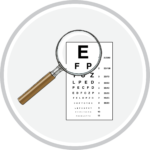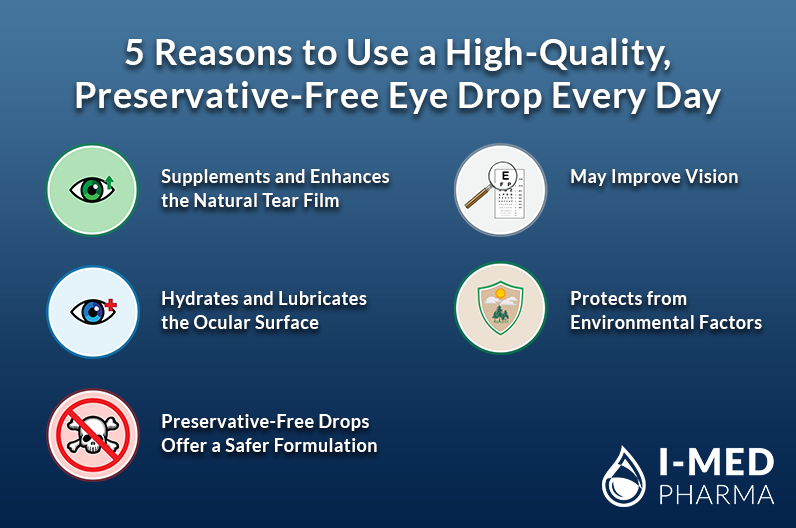(I-MED Pharma)
With Benjamin Itzkow, O.D.
“It is very important to ask the question about whether a patient has dry eye, because if you don’t ask the question, then you don’t get the answer, which is what happens most of the time.” – Dr. Itzkow
Eye drops are a standard management option for many conditions that can affect the ocular surface, including dry eye disease (DED). When used regularly, the right eye drop can help relieve discomforting ocular symptoms that can cause the sufferer to feel anything from mild, occasional discomfort, to severe, constant pain.
While there are many benefits to using eye drops to relieve symptoms, prevention is always better than a cure. So now the question becomes, can the right eye drops be used every day as a preventative measure against worsening dry eye symptoms?
To help with this question, Dr. Benjamin Itzkow, owner and optometrist of Eyes in the Village in Winnipeg, Manitoba, gives his opinion on this topic.
Dr. Itzkow, do you recommend using preservative-free eye drops every day as a preventative measure?
“Absolutely. This is like when dentists ask their patients to brush their teeth every day. In this case, optometrists are asking their patients to protect their eyes daily to help with the prevention of disease. A great way to get a patient to incorporate eye drops into their daily routine is to suggest they use the drops when they brush their teeth. One drop in the a.m. and one drop in the p.m. is all they’ll need to get started, and from there, the patient will be hooked! It’s an easy way to start using drops and there are many added benefits to using the right eye drop every day.”
Thank you, Dr. Itzkow, for your answer to this question. To expand more on this topic, here is a list of the top 5 benefits which can come from using a high-quality, preservative-free eye drop every day:
- Supplements and Enhances the Natural Tear Film

Any dry eye sufferer knows how important the natural tear film is and how it impacts how the eyes feel. Without the proper quality or quantity of natural tears, the eyes can feel dry, scratchy, itchy, irritated, and look red, and besides causing these discomforting symptoms and pain to the sufferer, can also cause damage to the ocular surface.
The natural tear film is made up of three layers: the lipid layer, the aqueous layer, and the mucin layer. A high-quality eye drop works to enhance the three natural layers of the tear film and leads to better quality tears by stabilizing the tear film’s lipid layer, correcting the osmolarity of the tears, and increasing the water retention.
Another unique property of the natural tear film is that it is a fluid that changes viscosity depending on whether force is applied, for example while blinking. Natural tears become more fluid during blinking, causing the tears to spread and coat the ocular surface. Then, when the blink is complete, the tear film returns to a more solid viscosity to protect the open eye. A high-quality eye drop should closely mimic this behaviour so that the artificial tear protects the eyes in the same way a healthy, natural tear film does.
- Hydrates and Lubricates the Ocular Surface

A high-quality eye drop should contain ingredients that provide hydration and lubrication to the ocular surface.
Hyaluronic acid (HA) is an ideal, natural lubricant that is present everywhere in the body, such as in the joints, connective tissues, and skin. HA is also highly hydrophilic, meaning water molecules are very attracted to it. An eye drop that contains superior quality HA with a high molecular weight will have fluid properties that more closely mimic natural tears such as high viscosity, elasticity, and shear-thinning properties.
Glycerin is a lubricant that acts as a demulcent and an osmoprotectant. As a demulcent, glycerin forms a soothing film over a mucous membrane to relieve minor pain and inflammation. As an osmoprotectant in eye drops, glycerin increases the volume of tears and decreases the salt concentration of the tear film, both of which help to prevent damage to the ocular surface.
- Preservative-Free Drops Offer a Safer Formulation

Preservatives can be toxic for the eyes. Unfortunately, preservatives are used in many formulations that are intended for the eyes, with benzalkonium chloride (BAK) being used in approximately 70% of ophthalmic formulations.1 BAK exposure can cause damage to the conjunctival and corneal epithelial cells in as little as seven days, resulting in signs and symptoms of ocular surface disease (OSD).2
Choosing to use a preservative-free eye drop avoids the potential cytotoxic damage to the eyes that is associated with preserved formulations while gaining the benefits of protecting, supplementing, and enhancing the ocular surface and tear film.
- May Improve Vision

Quality of vision is partially dependent on the tear film, as this is the first refractive surface which light travels through to reach the retina.3 When the tear film is unstable, it breaks down between blinks and exposes the ocular surface. This affects the quality of the image through two properties, aberrations and light scattering, which are the main causes of optical quality degradation in human eyes. 4
Visual complaints such as fluctuating vision with blinking, blurred vision, glare, and eye fatigue, are common in patients with DED,3 where having an unstable tear film and ocular surface damage is common. A good quality tear film, or one that is supplemented with a high-quality artificial tear, coats and protects the ocular surface between blinking and prevents ocular surface damage, which also affects the refractive surface and impacts vision quality. This improves the optical quality, reduces visual phenomena such as blurring and glare, and prevents “eye fatigue” from struggling to see things under these dry eye conditions.
- Protects from Environmental Factors

Both the indoor conditions (such as heating, a/c, and fans) and the outdoor environment (such as sunlight, wind, and dryness) can have an impact on the tear film and how the eyes feel. In fact, even face mask usage, which is an essential protective measure against the spread of viruses, can have an effect on the ocular surface.
A good preventative practice to preserve the tear film is to avoid air blowing directly across the eyes to reduce the rate of evaporation of the tear film. This can occur when driving in a car with the vents pointed at the eyes, in an office-setting with powerful heating/cooling vents, or even when sleeping near a fan that moves the air directly across the eyes, especially when lagophthalmos may be a concern.
In addition to adjusting the environmental conditions when possible, using a high-quality, preservative-free eye drop daily is an effective and preventative eye care routine that can lead to better ocular comfort.
IN CONCLUSION, many factors can play a role in whether a person will develop signs and/or symptoms of dry eye. Certain factors such as diet, environment, and screen-time can be adjusted to help improve discomforting ocular symptoms and inflammation. Other factors such as genetics, hormones, and age, cannot be changed. Whatever may be leading to the development or worsening of discomforting dry eye signs and symptoms, using a high-quality, preservative-free eye drop every day, such as any of the products in the I-DROP® line of viscoadaptive tears, can help manage ocular irritation, discomfort, and pain and help the sufferer find the relief they need to function normally and enjoy life with good quality vision.
[1] Goldstein, M.H., Silva, F.Q., Blender, N. et al. Ocular benzalkonium chloride exposure: problems and solutions. Eye (2021). https://doi.org/10.1038/s41433-021-01668-x
[2] Zhong, Jing, Yuqing Deng, Bishan Tian, Bowen Wang, Yifang Sun, Haixiang Huang, Ling Chen, Shiqi Ling, and Jin Yuan. 2016. “Hyaluronate Acid-Dependent Protection and Enhanced Corneal Wound Healing Against Oxidative Damage in Corneal Epithelial Cells.” Journal of Ophthalmology 2016: 6538051–10. https://doi.org/10.1155/2016/6538051.
[3] D’Souza, Sharon, Sriram Annavajjhala, Prashansa Thakur, Ritika Mullick, S Tejal, and Naren Shetty. 2020. “Study of Tear Film Optics and Its Impact on Quality of Vision.” Indian Journal of Ophthalmology 68 (12): 2899–2902. https://doi.org/10.4103/ijo.IJO_2629_20.
[4] Koh, Shizuka. 2016. “Mechanisms of Visual Disturbance in Dry Eye.” Cornea 35 Suppl 1 (Supplement 1): S83–S88. https://doi.org/10.1097/ICO.0000000000000998.

